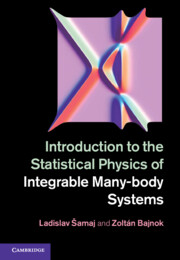Book contents
- Frontmatter
- Contents
- Preface
- PART I SPINLESS BOSE AND FERMI GASES
- PART II QUANTUM INVERSE-SCATTERING METHOD
- PART III QUANTUM SPIN CHAINS
- PART IV STRONGLY CORRELATED ELECTRONS
- 18 Hubbard model
- 19 Kondo effect
- 20 Luttinger many-fermion model
- 21 Integrable BCS superconductors
- PART V SINE–GORDON MODEL
- Appendix A Spin and spin operators on a chain
- Appendix B Elliptic functions
- References
- Index
20 - Luttinger many-fermion model
from PART IV - STRONGLY CORRELATED ELECTRONS
Published online by Cambridge University Press: 05 June 2013
- Frontmatter
- Contents
- Preface
- PART I SPINLESS BOSE AND FERMI GASES
- PART II QUANTUM INVERSE-SCATTERING METHOD
- PART III QUANTUM SPIN CHAINS
- PART IV STRONGLY CORRELATED ELECTRONS
- 18 Hubbard model
- 19 Kondo effect
- 20 Luttinger many-fermion model
- 21 Integrable BCS superconductors
- PART V SINE–GORDON MODEL
- Appendix A Spin and spin operators on a chain
- Appendix B Elliptic functions
- References
- Index
Summary
Low-temperature properties of 3D interacting fermion systems are well described by Landau's theory of Fermi liquids; for reviews see, e.g. [183, 184]. It involves only excitations of the system around the Fermi surface on energy scales small compared to the Fermi energy. Excitations are well described by quasi-particles which are in one-to-one correspondence with the bare particles. The bare-particle interaction does not break the qualitative picture of non-interacting system, but renormalizes the dynamical characteristics (the effective mass and the pair interaction) of quasi-particles. Within the microscopic Green function formalism, the existence of quasi-particles is equivalent to assuming that the self-energy correction Σ(k, ω) is regular (has only short-range contributions in time and space) close to the Fermi surface. The lifetime of quasi-particles τ α(εk−εF)−2 is long enough to consider them as well-defined eigenstates over long time-scales. The momentum occupation number of the bare particles exhibits a sharp discontinuity when crossing the Fermi momentum. The charge and spin degrees of freedom of quasi-particle always travel together.
The Landau theory breaks down in 1D systems of interacting fermions which have a very specific Fermi surface consisting of two points ±kF. In such systems, the self-energy Σ(k, ω) no longer possesses the analytic properties required for introducing quasi-particles. In contrast to Fermi liquids, the momentum occupation number of the bare particles in the ground state is continuous at the Fermi momentum. Moreover, the charge and spin excitations are separated.
- Type
- Chapter
- Information
- Publisher: Cambridge University PressPrint publication year: 2013



